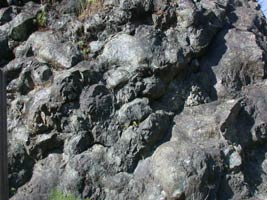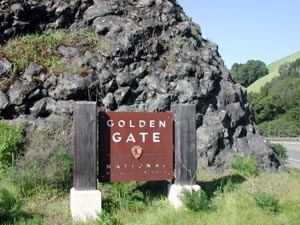|
These are samples of pillow basalts typical of the central California
coast. Basalt is the most common volcanic rock both of the sea floor
and of continental volcanoes.
Geologic History: |
| 1. Exuding lava: |
| 
|
Beneath the sea, basaltic magma exudes from midoceanic
ridges where crustal plates spread in opposite directions. The
seawater cools the surface of the basaltic magma quickly, forming
a solid crust over still fluid, hot lava. These crusts crack
and the molten lava oozes out, much like a strip of toothpaste
from its tube. In turn, this strips cools, its surface cracks,
and the process continues. The resulting rounded and elongate
shapes of the basalt give it the name of pillow basalt. |
| 2. Uplift: |

|
At this stop, we are standing near a former spreading
center or midoceanic ridge, under perhaps 10,000 feet of water.
The pillows formed as lava erupted on the sea floor, and cooled
quickly. As hot seawater circulating through it, a low-grade
metamorphism took place and the minerals, such as chlorite,
developed which give the basalt its dark green color, and
its common name greenstone. |
| 3. Faulting and
erosion: |
 |
This basalt is about 1370 m thick and it is broken by many
faults. Weathering (both biotic and abiotic) and erosion continue
to act on these pillows revealing some of their interior structure. |
|




